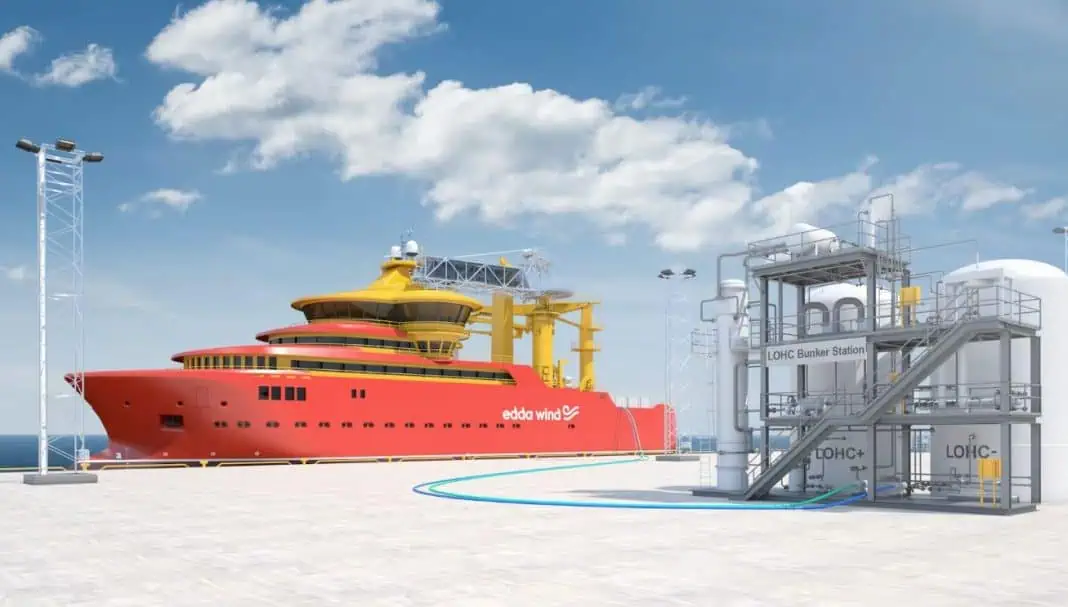The Ship-aH2oy project will develop and demonstrate a zero-emission propulsion technology on board ships using green hydrogen from liquid organic hydrogen carrier (LOHC) on a megawatt scale. The European Climate Infrastructure and Environment Executive Agency (CINEA) has informed the consortium of 17 partners that they will be granted 15 million Euros (project period: 5 years). The concept is based on the combined use of LOHC and solid oxide fuel cells (SOFC) as a powertrain, providing a significant improvement from conventional internal combustion engines. The project has real-lab character as the developed LOHC /SOFC powertrain will be demonstrated on board one of Edda Wind’s Commissioning/Service Operation Vessels (C/SOV)
Hydrogenious’ LOHC technology with the thermal oil benzyl toluene as the carrier material, already proven in stationary systems, allows for handling hydrogen in a very safe and efficient way, at ambient conditions and by utilizing existing infrastructure (transport, bunkering, etc). The gaseous hydrogen molecules are bound to and released from the carrier in a chemical catalyst process (hydrogenation/dehydrogenation), without no self-discharge over time. Due to the inherent characteristics of the carrier (non-explosive, hardly flammable, among others), the hazard potential is even smaller than for diesel and thus clearly superior to ammonia.
In Ship-aH2oy, Hydrogenious LOHC Technologies will oversee the detailed design of the LOHC release unit and the integration with the SOFC, whereas Hydrogenious LOHC Maritime will interface with the external SOFC supplier and take care of the entire system to be introduced and installed on the already pre-pared Edda Wind vessel. The design of a scalable system architecture for larger ships and power plants by integrating several megawatt LOHC/SOFC modules is consequently intended.

Østensjø Rederi as the project manager for the newbuilds is responsible for the key interface and machinery space contributions, and jointly with ship owner Edda Wind, the aim is to demonstrate the efficient operation of the onboard power plant using green hydrogen.
The Ship-aH2oy partners have already plans to retrofit several other vessels with LOHC/SOFC systems after the first successful demonstration of the technology. In the further course of the project period, a replication study for the developed LOHC/SOFC system will follow, allowing easy replication in e.g., service vessels and ROPAX-vessels.
Dr Caspar Paetz, CTO of Hydrogenious LOHC Technologies:
“The very special technological twist in the Ship-aH2oy project will be the targeted high-level thermal integration allowing SOFC residual heat to be used in the hydrogen release unit for the endothermic dehydrogenation process. With this targeted efficient heat integration, a high overall system efficiency can be achieved. Along with the inherent safety and handling benefits of LOHC, this makes it the very viable emission-free fuel for ships.”
Øystein Skår, General Manager at Hydrogenious LOHC Maritime:
“Within the Ship-aH2oy project, we will enter the range of megawatt drive power provided by emission-free LOHC technology. This depicts a relevant power range for a wide operation range of service operation vessels and other ship types. Thus, in Ship-aH2oy a significant reduction of greenhouse gas emissions can be achieved for a specific ship. Moreover, the project is a large step towards the serial production of on-board LOHC power systems in the megawatt range.”
Egil Arne Skare, Chief Project Officer at Østensjø Rederi:
“This grant demonstrates that the EU believes that LOHC is a technology that can cut emissions from offshore shipping. The EU support allows us to test this ground-breaking technology on board, and at the same time show that maritime operations for offshore wind can be carried out emission-free. Østensjø Rederi is proud to take part in a project that will make it easier to get more zero-emission ships with LOHC solutions at sea in the future”.
Kenneth Walland, CEO at Edda Wind:
“We are thrilled to be a part of Ship-aH2oy and to have the opportunity to demonstrate this cutting-edge technology onboard one of our vessels. With the support from EU and our excellent consortium partners, we are ready to take the next step toward zero-emission maritime operations for offshore wind farms.”
Basis of the Ship-aH2oy project is the strong commitment of the wide range of industry partners to realize zero-emission shipping. As the consortium covers the whole value chain from design-offices and class-society to ship builders, owners and operators, efficient dissemination and exploitation of the results will be a natural outcome of the project.













